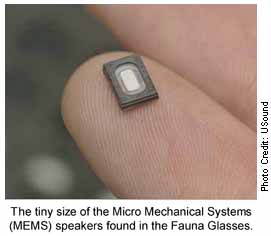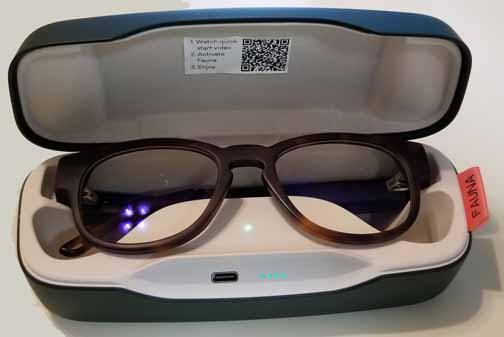







Eyeglasses historically provided people with improved sight through prescription lenses and reduction of sun glare plus protection from the sun’s harmful rays through the use of sunglass coatings. Smart Augmented Reality (AR) eyeglasses could soon superimpose computer-generated images or information onto a user's view of the real world. Apple has been working on a prototype AR system since 2015 and will have a marketable product by 2023. So far AR vision eyewear products have been geeky and have been mostly limited to sight impaired people and as a heads up display for surgical teams, scientists, engineers, students in special fields and workers in industrial settings.
A number of companies have rolled out what they are calling “smart glasses” that allow audio and photography in normal looking eyewear. In my opinion giving people the ability to secretly shoot video and photos is creepy and bound to get some wearers or their friends in trouble.
In this column we will take a look at what Fauna has added to the old eyeglass paradigm. Fauna eyeglasses have integrated into their frames Bluetooth technology plus Micro Mechanical Systems (MEMS) beam forming microphones and speakers. This allows the wearer to make and receive phone calls or listen to music without anything in their ears. Fauna glasses do not include the ability to take photos and therefore I felt the perfect product to describe how eyewear audio works.
Fauna eyeglasses come with sunglass or blue light filtering lenses. It is obvious what the sunglass lens will do but many people don’t realize that their computer, smartphone, and tablet screens also emit harmful rays that can be filtered out by blue filtering lenses. The glasses are designed so the lens they are shipped with can be removed and replaced by an optician with prescription lenses. The Fauna frames are physically light in weight (1.8 ounces) even though they are loaded with micro sized electronic components.
The physical look of the eyeglasses made it clear that the engineering team that designed them understood that function could not overshadow the physical form of the product if they wanted to successfully market them. The Fauna audio glasses that I tested are styled to please most fashion conscious consumers. See photo 1.
Before taking a look at features and specifications I want to point out what I feel is the most outstanding feature of this product. It allows you to be on your phone or listening to music with nothing stuck in your ears. This fact grants you full situational awareness when you are engrossed in a phone call or listening to music while jogging, walking, or performing other activities on public streets and roads.
The MEMS speakers, incorporated into this product, are designed to beamform sound waves directionally toward the wearers ears. The two MEMS microphones are also designed to beamform incoming sound to mostly pick up what the wearer is saying. Beam forming minimizes audio leakage to prevent the microphones from picking up the sound from the eyeglasses speakers which would create an echo that would be heard by the person on the other side of the phone call. To further prevent the microphones from picking up the sound produced by the MEMS speakers, the company incorporated echo cancelation technology which is a form of noise cancelation that targets any sound feedback from the speakers that might reach the microphones. The system does not fully prevent someone who is standing very close to the wearer from hearing ongoing conversations. The audio controls are built into the eyeglass frame arms and charging is performed when the glasses are placed into their storage case.
Conclusions from Product Testing
At this point you have a clear understanding of how this company incorporated electronics into the frames of these eyeglasses. The Fauna audio glasses retail cost is around $200.00 and they will work with both Apple and Android smartphones. My testing included switching between an expensive set of earbuds and the eyeglasses so I could compare music and phone call quality.
Reasons to Drool:
If you are a runner or walker, working out on public streets, this product allows you to be on your phone or listening to music with nothing stuck in your ears. The Bluetooth was very easy to set up. The eyeglasses only weighted 1.8 ounces and they were very comfortable to wear. The feedback from the people I called during testing, indicated that in windy and noisy conditions the Fauna microphones provided clearer audio than the microphones in the earbuds. An audio message tells you when the battery will soon need recharging. The charging case is well designed and dropping the glasses into it automatically shuts them off and starts recharging. A full charged case has the power to recharge the eyeglasses four times. To recharge the case you plug in a USB-C cable, a short cable is supplied but any USB-C will work.
Not So Cool:
Except for phone calls the earbuds audio was slightly superior; a difference noticed because of side by side testing. A full charged battery only lasted four hours which is not insufficient for wearing them all day. There is no way to tap the Fauna frames to determine the battery’s remaining charge. The charging case is too thick to fit into your pocket.
Taking it a Step Further
1. What do you see as the roadblocks to audio eyeglasses becoming popular?
2. Do you feel Augmented Reality in eyewear would tend to distract drivers and walkers and lead to more accidents? Why?
3. What features would you like to see incorporated into smart eyeglasses?